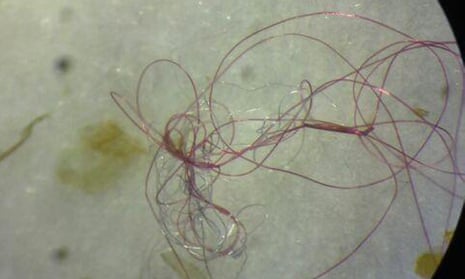A study in California has laid bare the staggering scale of pollution from plastic microfibers in synthetic clothing – one of the most widespread, yet largely invisible, forms of plastic waste.
The report, whose findings were revealed exclusively by the Guardian, found that in 2019 an estimated 4,000 metric tons – or 13.3 quadrillion fibers – were released into California’s natural environment. The plastic fibers, which are less than 5mm in length, are primarily shed when we wash our yoga pants, stretchy jeans and fleece jackets and can easily enter oceans and waterways.
“The findings were nothing short of shocking,” said Alexis Jackson, fisheries project director at the Nature Conservancy in California, which commissioned the study from a research team at the University of California, Santa Barbara. The study, which the authors describe as the first of its kind, has not yet been peer reviewed or published.
Many picture ocean plastic pollution as large debris such as bags, straws and bottles, but in fact the majority consists of tiny particles that accumulate in tiny organisms and rise in the food chain.
Their size makes it easy for them to collect in everything from plants to plankton. A recent study found that 73% of fish caught at mid-ocean depths in the Atlantic had microplastic in their stomachs.
The number – 13.3 quadrillion – is tricky to wrap one’s mind around, so the study’s authors have made more digestible comparisons: it’s 130,000 times as many fibers as there are stars in the Milky Way galaxy. It’s also equivalent to 80m rubber duckies’ worth of plastic polluting the state every year.
Thousands of plastic microfibers are shed when synthetic clothes get washed. The microfibers then surf through washing machines and end up in the wastewater stream. A 2016 study showed that an average-sized load of laundry could release more than 700,000 fibers into wastewater, though how much is shed depends on several factors: the type of garment, materials used, wash temperature and detergent. Currently, there are no washing machine filters that catch the particles.
These synthetic materials are unknown to the natural environment, so microbes and other creatures have not evolved to deal with them, says Roland Geyer, an industrial ecologist at UC Santa Barbara who collaborated on the report. “We are introducing these synthetic materials into the environment at a much larger scale than we initially thought. And that has people worried about the longer term environmental and health consequences.”
To come up with the final tally, the team combined data on synthetic fiber consumption with estimates of how often people wash their clothes, and how much those clothes shed in each wash. Then they used California-specific sludge and wastewater management information to follow the fibers and predict how many end up in bodies of water, landfills, incinerators or spread on land.
Wastewater plants have the ability to capture the fibers, but there’s a problem there, too. Plants are collecting the sludge and combining it with biosolids – a byproduct of sewage treatment – three-quarters of which gets treated then spread on agricultural fields. From there, the plastic fibers go right back into the waterways. “So we’re changing it from an ocean problem to a land problem,” says Geyer. “Rather than removing the fibers, we’ve just moved their location.”

The human health effects aren’t entirely clear, but a recent report found the average person ingests more than 5,800 particles of synthetic debris each year – and plastic fibers have been found in food, drinks and even in the Arctic. And the problem is increasing in magnitude: right now 60% of the material that makes up our clothes is synthetic. By 2050, the global production of synthetics is expected to triple, according to Jackson.
Many studies have looked at the conditions that cause clothes to shed fibers into the water system – and into the air, something known as dry shedding. Acrylic and polyester fabrics shed more than poly-cotton blends, according to a 2016 study. Thicker fabrics also shed more than thinner ones, newer garments shed more than older ones, hotter wash temperatures cause more fibers to shed than colder temperatures, and top-loading washers cause clothes to shed more than front-loading washers. Fewer studies have tried to assess the global impact of microfiber plastics in our environment.
Plastic production and incineration is also linked to the climate crisis. Global plastic production is projected to more than triple by 2050, accounting for 20% of all fossil fuel consumption and representing a significant increase in greenhouse gas emissions, Jackson says: “As a result of increasing carbon dioxide and other greenhouse gases, we’re seeing warmer, more acidic, and less productive ocean ecosystems.”
When it comes to solving the problem, the reports’ authors say answers have to come from all sides. Relying on wastewater treatment isn’t going to solve the issue. But advances in lint-catching technology for washing machines could make a big difference, keeping the fibers from escaping into the water system in the first place. In addition, clothing companies are increasingly examining the production process and trying to create fabrics with lower shed rates. “I think the consumer can help by demanding action,” says Geyer.
Jackson points out that the microfibers collected in wastewater plants could be carefully put in non-leaking landfills instead of spread on agricultural fields – or there could be even more creative solutions in the future. “When you look at fishing nets or even other types of plastic, there are innovative ways to reuse or reduce these materials, so we have to keep looking for innovative solutions.”
California has long been a leader in environmental action, says Jackson, including renewable energy and plastic bag bans. But until now, it’s been unclear how much the microplastic issue has been plaguing the state. “It’s important to understand our part of the problem, especially in a state that prides itself on being forward-thinking.”
